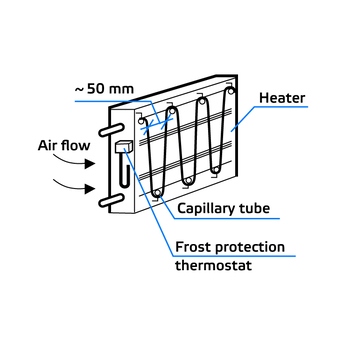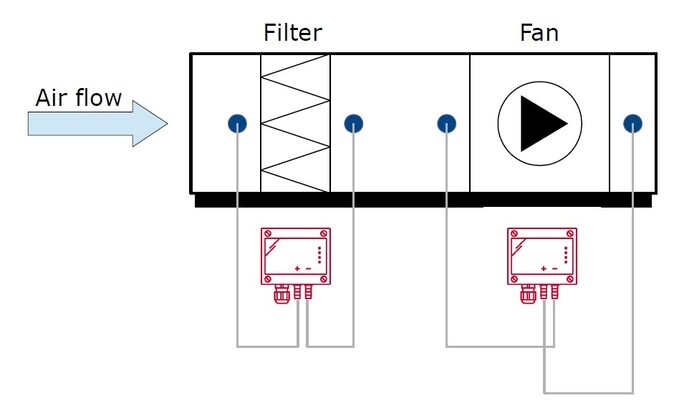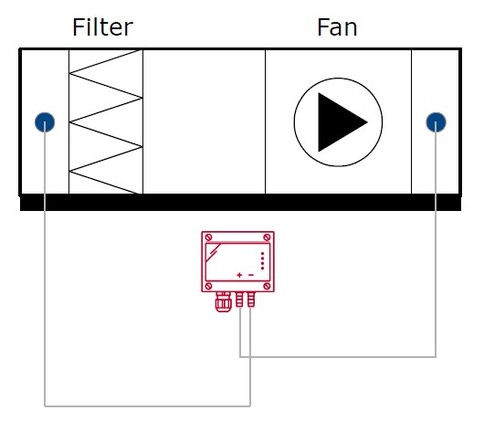What is the best placement for sensors on air handling unit?
Sentera offers a wide range of control solutions for your air-handling units (AHU). These solutions include various sensors, a certain amount of which come pre-wired; however, some articles are connected on-site. In this article, we prepared best practices and tips for installation of our most common solution products.
Frost protection thermostat
A frost protection thermostat is a critical component for air handling units (AHUs), particularly in cold climates. It prevents the freezing of water in the coils of the heating system, which could otherwise lead to severe damage. By continuously monitoring the temperature of the air leaving the coil, the thermostat ensures that the system reacts promptly to any potential drop in temperature that could lead to freezing conditions.
The thermostat should be installed evenly downstream of the heater, where it can accurately sense the air temperature leaving the coil. Generally, the capillary tube should cover the full surface of the coil, with loops placed at regular intervals, usually 50 mm apart. This spacing ensures an even temperature distribution and prevents localized freezing. Secure the capillary tube firmly to the coil to prevent any movement that could lead to inaccurate temperature readings. Additionally, care should be taken to avoid kinks or sharp bends in the capillary tube, as they could impair its functionality.

A frost protection thermostat is a critical component for air handling units (AHUs), particularly in cold climates. It prevents the freezing of water in the coils of the heating system, which could otherwise lead to severe damage. By continuously monitoring the temperature of the air leaving the coil, the thermostat ensures that the system reacts promptly to any potential drop in temperature that could lead to freezing conditions.
The thermostat should be installed evenly downstream of the heater, where it can accurately sense the air temperature leaving the coil. Generally, the capillary tube should cover the full surface of the coil, with loops placed at regular intervals, usually 50 mm apart. This spacing ensures an even temperature distribution and prevents localized freezing. Secure the capillary tube firmly to the coil to prevent any movement that could lead to inaccurate temperature readings. Additionally, care should be taken to avoid kinks or sharp bends in the capillary tube, as they could impair its functionality.

Differential pressure relays and sensors
The measurement of differential air pressure in air-handling units is mostly used when monitoring the condition of filters or the operation of fans. Less often use cases include controlling the status of heat exchangers (coolers and recuperators) in order to prevent them from freezing.
The most common devices for pressure measurements are relays and sensors. Although pressure relays are cheaper, we use sensors in our solutions for the following reasons:
1) Reduced maintenance costs by extending the service time of the filters;
2) Reduced energy costs by precisely indicating filter clogging;
3) Indicating equipment status remotely and therefore, eliminating unnecessary checks
In addition, pressure relays activate only when a measured value exceeds the selected threshold. Bearing this in mind, we cannot use them for fan monitoring, where a range instead of a single value is necessary to determine if the fan operates normally.
Typical installation cases are shown on the drawing below:

We strongly recommend avoiding the following installation:

It is inapplicable and incorrect for the following reasons:
• Users are unable to determine what the reason for differential pressure change is – a polluted filter or a malfunctioning fan;
• In most cases, there is other equipment between a filter and a fan (e.g. heat exchangers and/or recuperators). However, filters are elements, which are the most likely reason for differential pressure increase. That is why they should be monitored separately. By doing so, we make sure that the increase in differential pressure does not come as a result of a serious issue.
Mounting the probes is probably the most critical point of the entire sensor installation process. The tubing should be as short as possible while still allowing for adequate routing between the sensing points. Aim to keep the tubing length under two meters if possible. Route the tubing in a way that avoids sharp bends, kinks, or loops, as these can create pressure drop errors and potentially trap condensate or debris, affecting sensor accuracy. Use smooth, gradual bends and secure the tubing with clamps or cable ties to prevent movement and vibration, which can also impact readings. If readings seem inaccurate, check for issues like tubing leaks or blockages or electrical connection problems.
Temperature and humidity sensors
Sentera solutions feature a range of temperature and humidity sensors: outdoor, room, duct and surface-mounted sensors. For AHUs, we use duct and surface-mounted types in most cases.
Duct temperature and humidity sensors are used to control and monitor the operation of heat exchangers such as heaters, coolers and recuperators. These sensors provide real-time data that ensures the system operates efficiently and maintains optimal indoor air quality. To achieve the best reading, install a duct sensor in the middle of the duct wall and do not place it in an area where air stratification occurs. It is best to mount the sensor at least 1.5 meters in either direction from any elbows, dampers, filters, or other duct restrictions that could cause turbulence or uneven air distribution. Keep the sensor away from areas where it could be exposed to excessive vibrations, rapid temperature changes, or direct sunlight.
Surface-mounted temperature sensors are installed on the return pipe of a heater in order to monitor liquid temperature and ensure its frost protection. This sensor should be installed on a straight section of the pipe, away from bends, valves, or other disturbances that could affect temperature readings. The best practice is to install the temperature sensor right at the exit of the heating coil. After the sensor is mounted, insulate the pipe and the sensor to avoid heat loss and prevent inaccurate temperature readings. Additionally, using a high-quality thermal paste between the sensor and the pipe can improve thermal conductivity and ensure a faster response time to temperature changes.
You can find additional information here and there.
Sentera solutions feature a range of temperature and humidity sensors: outdoor, room, duct and surface-mounted sensors. For AHUs, we use duct and surface-mounted types in most cases.
Duct temperature and humidity sensors are used to control and monitor the operation of heat exchangers such as heaters, coolers and recuperators. These sensors provide real-time data that ensures the system operates efficiently and maintains optimal indoor air quality. To achieve the best reading, install a duct sensor in the middle of the duct wall and do not place it in an area where air stratification occurs. It is best to mount the sensor at least 1.5 meters in either direction from any elbows, dampers, filters, or other duct restrictions that could cause turbulence or uneven air distribution. Keep the sensor away from areas where it could be exposed to excessive vibrations, rapid temperature changes, or direct sunlight.
Surface-mounted temperature sensors are installed on the return pipe of a heater in order to monitor liquid temperature and ensure its frost protection. This sensor should be installed on a straight section of the pipe, away from bends, valves, or other disturbances that could affect temperature readings. The best practice is to install the temperature sensor right at the exit of the heating coil. After the sensor is mounted, insulate the pipe and the sensor to avoid heat loss and prevent inaccurate temperature readings. Additionally, using a high-quality thermal paste between the sensor and the pipe can improve thermal conductivity and ensure a faster response time to temperature changes.
You can find additional information here and there.
